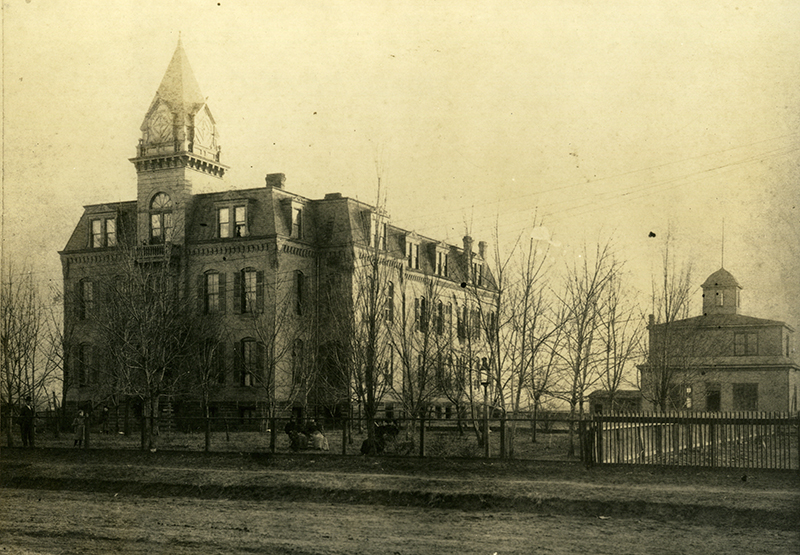
The Encyclopedia of Oklahoma History and Culture
CREEK (MVSKOKE) SCHOOLS.
Education efforts for the Mvskoke (Creek) in Indian Territory (present Oklahoma) began when the family and supporters of William McIntosh arrived there in 1829. Methodist records described early, limited schooling efforts. By 1832 Union Mission school, formerly a mission for the Osage Indians, and now listed in the National Register of Historic Places (NR 71000668), was the seat for both Baptist and Presbyterian work. When sixteen thousand displaced Mvskoke arrived in the West in 1836, both traditional and McIntosh leaders agreed to dismiss all missionaries from the Creek Nation. The traditional Mvskoke opposed Christian teaching, and the McIntosh faction, as slaveholders, sought an end to the preaching of abolition.
Although teaching had resumed by 1839, the wary Mvskoke, having sorted through varieties of negative experiences, including teachers plucked from classrooms for criminal activity, imposed conditions of admission for teachers. In 1841 Presbyterian missionary Robert N. Loughridge secured agreement for permission to build Koweta Mission (NR 73001571), a day school, which opened in 1843. In 1850 Loughridge had opened a large boarding school, Tullahassee Manual Labor School (NR 71000674), about ten miles north of present Muskogee. In the same period the Methodists opened Asbury Manual Labor School at North Fork Town, northeast of present Eufaula. These schools were open to girls as well as boys. Each boarding school accommodated eighty residential students but was limited in outreach, and many chiefs also opened primary day schools in their communities.
Early schooling experiences were checkered with frustrations of erratic attendance, unsupportive parents, and inexperienced teachers. Nevertheless, by 1855 students attended Arkansas College at Fayetteville and Cane Hill College in Cane Hill, Arkansas. However, all educational endeavors ceased during the American Civil War.
Returning Mvskoke war veterans helped negotiate a new tribal constitution in 1867. Tribal leaders codified a national common school system and defined the mission school presence in the Creek Nation. They also defined a program called "Youth-in-the-States" to send nominated Mvskoke students to colleges in the eastern United States, and the first eighteen went in 1876. The U.S. Indian agent to the Creek Nation supported the effort, commenting on the need for educated interpreters. "Youth-in-the-States" supported an estimated two hundred to four hundred students, including women and Freedmen. Colleges such as Drury, LaGrange, William Jewel, and Centralia in Missouri, Wooster in Ohio, and Arkansas Industrial in Fayetteville enrolled students. As late as 1895 the Mvskoke supported pupils in colleges as far away as New England.
In 1881 the Creek Nation awarded a charter to its first higher education institution, Harrell Institute, a Methodist school. By the mid-1890s Muskogee was home to no fewer than five higher education facilities: Edwards University, a Freedman's college; Harrell; Nazareth Institute (Catholic); Henry Kendall College (Presbyterian); and Indian University (Baptist).
Indian University, now Bacone College, began when the Creek Nation awarded Almon C. Bacone a charter and a land grant for his school in 1885. The history of Indian University includes the first Greek-letter fraternity in Indian Territory, Psi Delta; the first degrees awarded, the class of 1883; and a first Indian Territory football game, played against Henry Kendall College in 1895. In 1907 the Tulsa Commercial Club influenced Kendall College's move to Tulsa. Kendall was modified from a school for Indian students to become a Presbyterian synodical school. In 1921 it was rechartered as the University of Tulsa.
By the 1890s the Mvskoke permitted additional boarding schools. Wealaka replaced Tullahassee, which burned in 1880. (Coweta had closed in 1861.) Levering Mission (NR 74001662) operated near Wetumka, Nuyaka Mission (NR 72001075) west of Okmulgee, and Yuchi in Sapulpa. Several community day schools also served the tribe.
The Curtis Act of 1898 gave control of the Creek Nation's treasury to the U.S. Department of the Interior, leaving the tribe with no means to administer their school system. The federal government appointed a general superintendent of all Indian Territory schools. At 1907 Oklahoma statehood some schools remained under federal control, passed into the public school system, or were closed.
See Also
AMERICAN INDIANS, AMERICAN INDIANS AND CHRISTIANITY, AMERICAN INDIANS AND EDUCATION, CHEROKEE MALE AND FEMALE SEMINARIES, CHICKASAW SCHOOLS, CHOCTAW SCHOOLS, CREEK (MVSKOKE), SEMINOLE SCHOOLS






